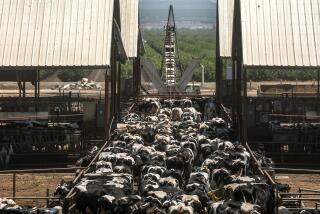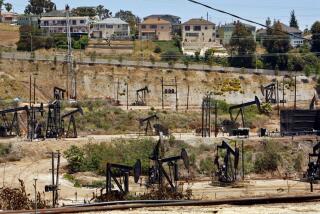Wells Are Suspected in Oil Leak
Natural seepage from the ocean floor is unlikely to be the source of oil that has killed or injured more than 1,000 seabirds along the Southern California coast, so investigators are focusing on inland wells that might have become uncapped during recent record rainstorms, state officials said Friday.
Tests revealed that oil on the birds’ feathers didn’t match the consistency of oil from natural seepage. A leak from an offshore oil platform hasn’t been ruled out, but officials doubt that was the culprit.
“We’re assuming it’s not a seepage, because what we’re seeing on the birds is oil that’s weathered, not the slimy, wet stuff that comes from the ground,” said Ken Mayer of the state Department of Fish and Game’s Office of Spill Prevention and Response.
Investigators are examining abandoned oil wells and working pipelines near the Ventura River that might have become uncapped or broken during the storms.
Oil-covered birds started washing ashore last week in Ventura County. But over the last few days, they have been found as far south as Huntington Beach. About 1,400 injured or dead birds have washed ashore so far, making this the California oil leak most harmful to wildlife since a 1990 tanker spill off Orange County.
“We are looking in the area where the birds were first found,” said Steve Edinger, the Fish and Game official overseeing the investigation for the department. “These birds usually stay close to shore. Something created this and it was dispersed, and they got near it.”
So much mud and debris washed down hillsides and mountain roads during the storms that oil companies haven’t been able to reach all their sites to check for leaks and damage, Edinger said.
If investigators can determine that a pipeline or well caused the spill, the owners could be liable for damages and prosecuted for criminal violations such as negligence, intentional dumping and polluting the environment, he said.
What’s so confounding to experts is the lack of any telltale slick on the water or tar balls washing ashore, indications of a dangerous spill.
A slick photographed last week around an offshore platform near Santa Barbara is unlikely to have caused the damage, Edinger said, because it is 20 miles from where the first oil-covered birds were discovered.
“State investigators are fairly confident it wasn’t coming from the platform holds,” he said.
Although officials believe they are getting closer to identifying a cause, they admitted that they might never solve the mystery.
“That’s a possibility,” Edinger said. “But I have the foremost confidence that we will be able to determine where it came from.”
The incident is the first major test for the Office of Spill Prevention and Response, created after the American Trader spill off Huntington Beach killed 3,400 birds in 1990.
About 200 staff members and consultants are involved in the investigation, according to officials, who could not say how much the operation had cost so far.
Wildlife experts say as many 5,000 birds may have been coated with oil in this incident, while state officials estimate the number at 3,000. The experts, who have been working around the clock to clean and rehabilitate the injured birds at the Oiled Bird Care and Education Center in San Pedro, released 17 grebes, a cormorant and a surf scoter Friday.
Freed from their cardboard boxes, the birds cautiously floated in the placid water at Cabrillo Beach, but their pace gradually quickened until they disappeared from view.
Numbered plastic bands on their legs will allow officials to identify the birds should they die and be found by fishermen, beachgoers or others. So far 77 birds injured in the oil spill have been released. Their chances for survival are unknown.
More to Read
Sign up for Essential California
The most important California stories and recommendations in your inbox every morning.
You may occasionally receive promotional content from the Los Angeles Times.










